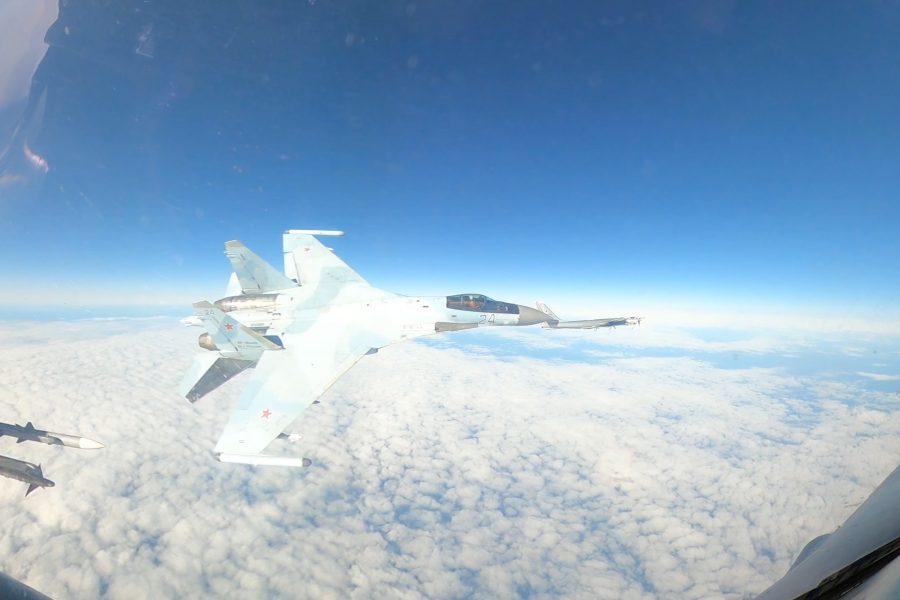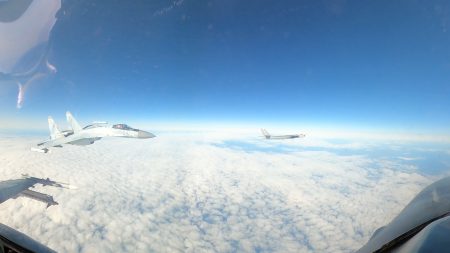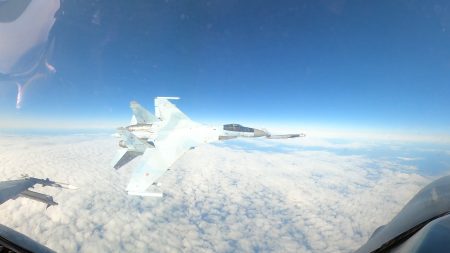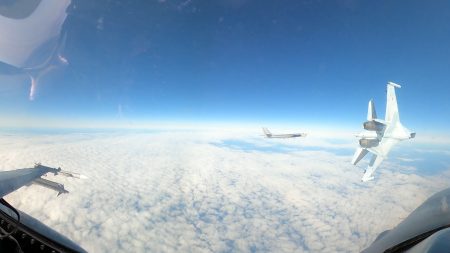A Russian Su-35 fighter cut across the front of a U.S. Air Force F-16 conducting a routine intercept of Russian aircraft off the coast of Alaska in a dramatic incident Sept. 23. The U.S. military called the encounter “unsafe,” and said the Russian aviator’s actions were “unprofessional and endangered all.”
The U.S. F-16, which was assigned to North American Aerospace Defense Command (NORAD), made the intercept in the Alaska Air Defense Identification Zone (ADIZ) in international airspace. Video and images released by NORAD show the F-16 shadowing a Russian Tu-95 before a Su-35 fighter cuts across the nose of the F-16 in what is known as a “headbutt” maneuver.
“NORAD aircraft flew a safe and disciplined intercept of Russian Military Aircraft in the Alaska ADIZ,” NORAD commander Air Force Gen. Gregory M. Guillot said in a statement posted on social media. “The conduct of one Russian Su-35 was unsafe, unprofessional, and endangered all–not what you’d see in a professional air force.”
The pilot of the U.S. Air Force F-16, which had a video camera mounted inside, can be heard exclaiming in apparent surprise as the Su-35 Flanker raced past them. The U.S. F-16 appeared to be carrying AIM-9 Sidewinder and AIM-120 AMRAAM air-to-air missiles.
The F-16 is likely from the 18th Fighter Interceptor Squadron, based at Eielson Air Force Base. That is the Viper unit tasked with conducting many of the intercepts of Russian—and recently Chinese—aircraft in the Alaska ADIZ. Russian aircraft entered the Alaskan ADIZ four times in September, according to NORAD. The Sept. 23 intercept involved four Russian aircraft, the command said in a news release at the time.
“We’re postured well to respond when those forces come into the Air Defense Identification Zone of Alaska, and you’ve seen that play out,” Air Force Lt. Gen. Case Cunningham, the head of the Alaskan NORAD Region, Alaskan Command, and the 11th Air Force, told Air & Space Forces Magazine in an interview earlier this month.
The Russian and Chinese flights were all in international airspace as the Alaska ADIZ stretches beyond American and Canadian territory, and ADIZ intercepts around the world often occur, including intercepts of American aircraft.
The Russian Air Force has previously shown it is ready to engage in aggressive tactics, most notably in Syria in which Russian aircraft came close to U.S. fighters, surveillance aircraft, and drones in 2023, though that behavior appears to have decreased this year in the Middle East.
“The biggest risk for all of us is these aircraft are not flying on training missions; they’re on combat missions,” then-Air Forces Central commander Lt. Gen. Alexus G. Grynkewich said of the incidents over Syria in June 2023. “Our aircraft have live weapons on board; the Russian aircraft have live weapons on board. And this kind of behavior just really increases the risk of a miscalculation, some sort of an incident occurring that’s unintentional.”
In July 2023, Russian Su-35 aircraft damaged two U.S. MQ-9 Reaper drones with flares when they passed in front of the drones. That incident came just months after the U.S. was forced to crash an MQ-9 into the Black Sea in March 2023 after a Russian Su-27 clipped the drone’s propeller, rendering the Reaper unrecoverable, according to the U.S. military.





